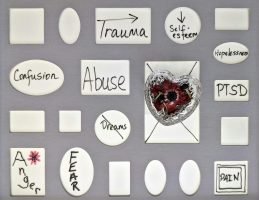This article refers to the relationship of three young girls we’ll call Lily, Daisy, and Rose. We are concealing their real names to protect their confidentiality.
My dearest friend has recently told me that his daughter, Lily, has encountered a toxic friend. Lily is just 12 years old, and her best friend is Daisy.
It’s really important for you to know Lily. She is an amazing young lady, with a kind heart and welcoming spirit. Lily met Rose at the mall and they became fast friends. Lily introduced Rose to Daisy.
Lily, Daisy, and Rose started spending time together and all seemed well. However, over time, Rose – wanting to be Lily’s only friend – became jealous and a threat to Daisy. Like any other toxic individual, Rose started to think of ways to eliminate Daisy from their circle. She used the usual tactics of manipulation, blackmailing, and gaslighting. She became passive-aggressive and overly emotional. Rose’s toxicity pushed Lily to the brink – forcing her to make a decision whether to remove Daisy from the group. Of course, Lily and Daisy’s friendship is far too important to Lily; she should never have been forced into this predicament. For Lily, the best solution would be to have both friends and be able to spend quality time with both of them unbothered.
Lily’s father noticed this dilemma, as he has helped her become self-aware and taught her how to respect herself and create healthy boundaries. However, in this case he could not intervene – Lily had to contend with the toxicity and decide for herself. As time passed, Rose became more unrelenting and demanding. Lily, with the support of her grounded father, gathered strength and told Rose that she needed to create healthy boundaries. Lily was clear with Rose, stating that she would be there for her and that she wanted to continue their friendship when Rose could respect her and her choices. Lily also told Rose that there is room in their circle to include Daisy.
Lily felt confused and saddened that Rose forced her to choose between her and Daisy – Lily’s desire to be friends with both girls should have been considered, honored, and respected by Rose. It wasn’t easy for Lily to stand up for herself and speak her mind, but she succeeded.
TAR (Toxic Abusive Relationships) are everywhere, and they begin to manifest in the early teen years. Unfortunately, many parents and other adults view this toxicity as normal – because either they are so ingrained in their own toxicity or they are blind and deaf to what their teens are revealing (or not) to them.
Developmentally (according to Erik Erikson’s stages of psychosocial development), as your little child grows into a young teen, they face a whole new set of challenges that will result in their asserting their identity. As parents, we need to brace ourselves for these life-altering conflicts, but we need to understand that our kids are not changing just to torment us. Also as parents, we need to adjust how we interact with and treat them. Mutual respect and understanding is crucial to helping our teens resolve the conflict Erikson calls “Identity vs. Role Confusion.” The positive resolution of this conflict will help us to guide and support our children through their tough times.
As they move through this phase of their lives, new and exciting emotions come alive. They start to recognize themselves for who they are, and they become more aware of their romantic and sexual feelings. While many cultures still consider dating between young teens taboo, it is inevitable – it’s certainly better to teach the right lessons and guide them, rather than impede or prohibit dating.
Many tweens & teens, at this point in their journey, may not understand the nuances that define healthy and toxic relationships. Because the line between love and possessiveness can be blurred or jagged, over time the distinction becomes lost in chaos. Here are some signs that your teen is in a toxic, unhealthy relationship and how you can reach out to help them.
Your teen spends less time with friends and family.
Although it’s typical for teens to distance themselves from their family, if they do it after getting into a relationship, then it could be a warning sign. If your teen’s boy/girlfriend is excessively jealous, possessive, or controlling – limiting their time with their friends and/or family – open the discussion with care, respect, and empathy. Threats and keeping your child away from the relationship will be met with anger and resentment. Help your child to see that your concern is only for them.
You can sense low self-esteem in your child.
When a teen is in a toxic relationship, you may notice a significant reduction in their self-confidence. They start to have difficulty making their own decisions, expressing their opinions, and putting forth their ideas. This happens because your teen’s partner blatantly shows a lack of respect for your child’s goals and ambitions, negatively affecting their self-esteem.
Mood swings become more common.
It is important to note any change in your teen’s mood or their personality. Being in a relationship with a toxic person alters how one behaves or feels about themselves. While they may try their best to please their girl/boyfriend, they may have a completely different attitude towards people who love them. Any personality changes are a reflection of being controlled or belittled.
Helping your teen through a toxic relationship.
As parents, again, it’s important to communicate love and caring for your growing and maturing child. Listen to them and provide them with the support they need without placing blame or guilt. Agree, as much as possible, with what your child has to say, but also give them necessary advice. Show concern, ask them what they believe they need, and avoid ultimatums.
Next, decide on resolving problems together. Let them know what you think is best for them without shutting down their opinions.
Most importantly, let your teen recognize when a relationship is unhealthy. For instance, ineffective communication is one of many signs of toxic relationships. This includes not listening, getting defensive, expecting others to instinctively get your point and emotions, and avoiding confrontations. In all intimate and personal relationships, one person must not control the other’s actions and emotions. Jealousy and possessiveness are the most negative – and obvious – traits.
My friend’s little girl is the hope that we are all looking for – a young person who is strong enough to stand up for herself, who respects herself and her boundaries, who tells right from wrong, and is fearless when speaking her mind. She is honest, empathic, and understanding – she is the girl many of us wished we were when we first encountered a toxic abusive relationship. Lily represents the future we all wish for our children. She is a warrior with a kind heart. She is the gift that we should give to ourselves and our children this Christmas. She guides us and shows us that it’s possible to stay true to ourselves, create healthy boundaries and outrightly reject TAR.
Lily is the reason TAR Network exists and continues the mission of helping victims of TAR and educating tweens & teens on how to shield themselves from TAR.







